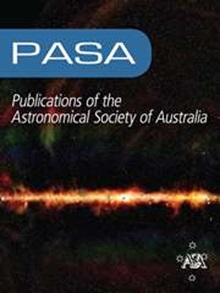星点纵向迁移的一些发现
IF 4.6
3区 物理与天体物理
Q1 ASTRONOMY & ASTROPHYSICS
Publications of the Astronomical Society of Australia
Pub Date : 2024-04-11
DOI:10.1017/pasa.2024.28
引用次数: 0
摘要
我们介绍了表现出显著振荡的冷恒星点的纵向迁移结果,并探讨了其可能的原因。我们利用开普勒卫星观测到的从F到M不同光谱型的9个目标系统的高质量数据进行了分析。研究光斑行为的系统如下:KIC 4357272、KIC 6025466、KIC 6058875、KIC 6962018、KIC 7798259、KIC 9210828、KIC 11706658、KIC 12599700 和 KIC 8669092。基本恒星参数是通过使用 PHOEBE V.0.32 软件进行光曲线分析计算得出的,光曲线的建模是为了获得由旋转调制引起的、发生在日蚀相位外的正弦变化。随后,我们利用傅立叶变换计算所获得的正弦变化的最小时间。通过线性拟合计算出这些最小时间对应的θ min 随时间的分布,从而确定斑点区域的纵向迁移。然后,我们将纵向迁移周期与文献中的恒星参数进行了比较。此外,除了线性模型之外,我们还发现了光斑迁移的二次变化。我们的结果表明,纵向迁移周期的变化与恒星的 B - V 色指数有关。本文章由计算机程序翻译,如有差异,请以英文原文为准。
Some Findings from the Longitudinal Migration of Starspots
We present results regarding the longitudinal migrations of cool stellar spots that exhibit remarkable oscillations and explore their possible causes. We conducted analyses using high-quality data from nine target systems of various spectral types, spanning from F to M, which were observed by the Kepler Satellite. The systems in which the behaviour of the spots was examined are as follows: KIC 4357272, KIC 6025466, KIC 6058875, KIC 6962018, KIC 7798259, KIC 9210828, KIC 11706658, KIC 12599700, and KIC 8669092. Basic stellar parameters were calculated from light curve analysis using the PHOEBE V.0.32 software, and light curves were modelled to obtain sinusoidal variations occurring out-of-eclipses phases, induced by rotational modulation. Subsequently, we calculated the minimum times of the obtained sinusoidal variations using the Fourier transform. The distributions of θ min corresponding to these minimum times over time were computed using linear fits to determine the longitudinal migrations of the spotted areas. We then compared the longitudinal migration periods with the stellar parameters found in the literature. In addition, we also found a secondary variation in the spot migrations apart from the linear models. Our results revealed that the longitudinal migration periods vary in relation to the B – V colour index of the stars.
求助全文
通过发布文献求助,成功后即可免费获取论文全文。
去求助
来源期刊
CiteScore
5.90
自引率
9.50%
发文量
41
审稿时长
>12 weeks
期刊介绍:
Publications of the Astronomical Society of Australia (PASA) publishes new and significant research in astronomy and astrophysics. PASA covers a wide range of topics within astronomy, including multi-wavelength observations, theoretical modelling, computational astronomy and visualisation. PASA also maintains its heritage of publishing results on southern hemisphere astronomy and on astronomy with Australian facilities.
PASA publishes research papers, review papers and special series on topical issues, making use of expert international reviewers and an experienced Editorial Board. As an electronic-only journal, PASA publishes paper by paper, ensuring a rapid publication rate. There are no page charges. PASA''s Editorial Board approve a certain number of papers per year to be published Open Access without a publication fee.

 求助内容:
求助内容: 应助结果提醒方式:
应助结果提醒方式:


